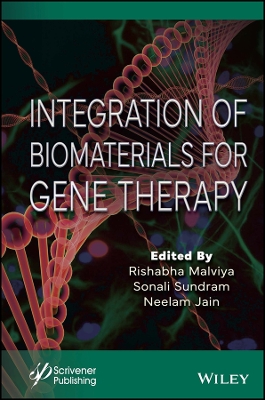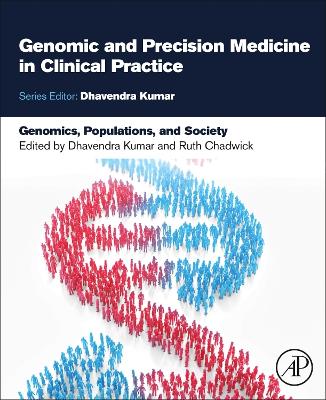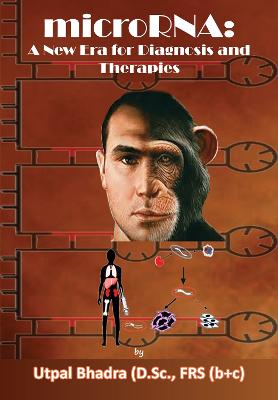Integration of Biomaterials for Gene Therapy
 portes grátis
portes grátis
Integration of Biomaterials for Gene Therapy
Jain, Neelam; Malviya, Rishabha; Sundram, Sonali
John Wiley & Sons Inc
05/2024
464
Dura
Inglês
9781394174737
15 a 20 dias
666
Descrição não disponível.
Foreword xvii
Preface xix
Acknowledgment xxi
1 Biocompatible Hydrogels for Gene Therapy: Advancement and Applications 1
Ankita Gupta and Swatantra K.S. Kushwaha
1.1 Introduction 2
1.2 Hydrogels Classification 3
1.3 Fabrication of Hydrogels and Its Desirable Technical Features 4
1.4 Factors to be Tuned for Gene Encapsulation in Hydrogels 4
1.5 Recent Advances on Hydrogels for Gene Delivery 6
1.6 Conclusion 9
2 Use of Polysaccharides: Novel Delivery System for Genetic Material 13
Prashant Kumar, Swatantra K.S. Kushwaha, Neelottama Kushwaha, Abhishek Singh and Surya Nath Pandey
2.1 Introduction 14
2.2 Cross-Linking Techniques for Engineering Polysaccharides-Based Biomaterials 23
2.3 Approaches to Design Polysaccharide-Derived Biomaterials 26
2.4 Biomedical Applications of Polysaccharide-Derived Biomaterials 29
2.5 Advanced Biomaterials for Wound Dressings 30
2.6 Scaffolds for Tissue Engineering and Development of Bioinks for 3D Bioprinting 30
2.7 Recent Utilization of Polysaccharides 31
2.8 Toxicity Concerns of Polysaccharide-Derived Biomaterials 33
2.9 Preclinical and Clinical Studies on Gene Delivery Using Polysaccharide-Based Biomaterials 33
2.10 Challenges and Future Directions 34
2.11 Future Prospects 35
2.12 Conclusion 35
3 Polysaccharide-Based Biomaterials for Gene Delivery 47
Ankita Moharana, Abhitav Tiwari, Shalini Perada, Shivlal Yadav and Om Prakash Kumar
3.1 Background 48
3.2 Introduction 49
3.3 Gene Therapy 51
3.4 Gene Delivery Systems Based on Polysaccharides 53
3.5 Practical Application of Gene Delivery Systems 56
3.6 Polysaccharide-Based Nanoparticles 57
3.7 DNA Delivery 63
3.7.1 siRNA Delivery 65
3.8 Conclusion 70
4 Hydrogel-Based Gene Therapy 77
Shweta Kumari, Dipti Jena, Vedant Kumar Prajapati, Shashi Ranjan Singh and Garima Tripathi
4.1 Introduction 78
4.2 Gene Therapy 83
4.3 In Vivo Gene Therapy Using Hydrogels 86
4.4 Encapsulating Cells in Hydrogels for Gene Therapy Delivery 87
4.5 Hydrogels for Integrative Tissue Engineering and Cell Delivery 89
4.6 Biocompatible Hydrogels for Transferring Cells 91
4.7 Using Hydrogels for Gene Therapy in Tissue Engineering-Based Drug 93
4.8 Human Gene Therapy that Uses Hydrogel as an Alternative Method of Delivering Genetic Material to Patients 94
4.9 Recent Advancement in Biocompatible Hydrogel 96
4.10 Applications of Hydrogel 99
4.11 Current Hydrogels in Clinical Trials 104
4.12 Conclusions 106
5 Progress and Prospects for Non-Viral Gene Therapy 117
Shashimala Tiwari
5.1 Introduction 118
5.2 Definition 118
5.3 Technology Overview for Non-Viral Gene Delivery 119
5.4 Chemical Carriers for Gene Transfer: Establishing Effective In Vivo Gene Delivery 121
5.5 Types of Gene Delivery 122
5.6 Reduction of Immunological Responses Through Alteration of Delivery Method or DNA Structure 124
5.7 To Enable Long-Lasting Gene Expression, Self-Replicating, Tissue-Specific, and Integrating Plasmid
Expression Systems are Designed 124
5.8 Hybrid Vector Systems to Improve Transfection and Lessen Cytotoxicity 125
5.9 Vehicle Material 127
5.10 Further Effects 129
5.11 Challenges and Prospects 130
5.12 Conclusion 132
6 Nanoparticles for Tumor Gene Therapy: Recent Advances and Perspective 139
R. Shivhare, V. Sabale, A. Ingole and Neelam Jain
6.1 Introduction 140
6.2 Technologies for Gene Delivery 142
6.3 Cancer Treatment with Gene Therapy 147
6.4 Gene Therapy Using Nanotechnology 147
6.5 Challenges and Future Aspects 160
7 Effective Gene Transfer with Non-Viral Vectors 183
Anil Kumar Mavi, Sonal Gaur, Neelesh Kumar, Avanish Kumar Shrivastav, Sankha Bhattacharya,
Sateesh Belemkar, Saurabh Maru and Dhruv Kumar
7.1 Introduction 184
7.2 System Development for Delivering Genes 186
7.3 Methods for Non-Viral Vector for Delivery of Genes 186
7.4 Delivery System 203
7.5 Current Methods for Nonviral Gene Delivery: Benefits and Drawbacks 209
7.6 Current Barriers for Non-Viral Vectors 210
7.7 Possibilities for Enhancing the Non-Viral Vector Delivery System 212
7.8 Conclusion 212
7.9 Future Relevance 213
8 Utilization of Chitosan for Gene Delivery 223
Johnson Olaleye Oladele
8.1 Introduction 224
8.2 Cationic Polymers-Based Gene Delivery Systems 225
8.3 Chitosan and Its Derivatives in Gene Delivery Systems 228
8.4 Chitosan as Chemotherapeutic Drugs 234
8.5 Conclusion 236
9 Nanoparticles as Gene Vectors in Tumor Therapy 247
Efstathia Triantafyllopoulou, Orestis Kontogiannis, Nefeli Lagopati, Natassa Pippa and Maria Gazouli
9.1 Introduction 248
9.2 Polymer-Based Nanocarriers: Their Technology and Recent Advances 249
9.3 Conclusions 271
10 Progress in Non-Viral Delivery of Nucleic Acid: Advancement in Biomedical Technology 281
Anil Kumar Mavi, Manmohan Kumar, Amarjeet Singh, Mahendra Kumar Prajapati, Rakhi Khabiya, Saurabh Maru and Dhruv Kumar
10.1 Introduction 282
10.2 Physical Methods of Non-Viral Nucleic Acid Delivery System 285
10.3 Advantages and Disadvantages of Physical Transfection 296
10.4 Chemical Methods of Non-Viral Nucleic Acid Delivery System 296
10.5 Advantages and Disadvantages of Chemical Transfection 308
10.6 Cellular Barriers for Nucleic Acid Delivery Faced by Non-Viral Vectors 309
10.7 Challenges and Limitations of Non-Viral Nucleic Acid Delivery System 311
10.8 Conclusion 311
11 The Junction of Biomaterials and Gene Therapy -- Current Strategies and Future Directions 323
Ranjan Kumar Singh, Sunita Panchawat, Chennu M.M. Prasada Rao, Joohee Pradhan, Rajeswari Tanniru, Deepika Bairagee and Ajay Kumar Garg
11.1 Introduction 324
11.2 Viral Gene Therapy 327
11.3.1 Adenoviral Vectors 329
11.4 Adeno-Associated Viral Vectors 330
11.5 Non-Viral Gene Therapy 331
11.6 Recent Advances in the Development of Gene Delivery Systems 334
11.7 Development of Gene Delivery Systems 335
11.8 Viral Vectors Based on DNA for Gene Delivery Systems 336
11.9 Viral Vectors Based on RNA for Gene Delivery Systems 337
11.10 Oncolytic Viral Vectors for Gene Delivery Systems 337
11.11 Practical Application of Gene Delivery Methods 343
11.12 Conclusion 347
12 Utilization of Silk for Gene Delivery 349
Swatantra K. S. Kushwaha, Shruti Khare and Neelottama Kushwaha
12.1 Introduction 350
12.2 Dimensional Structure of Silk 350
12.3 Properties of Silk 351
12.4 Extraction of Fibroin from Silk Worm 352
12.5 Fabrication of Silk in Different Therapeutics Carriers 353
12.6 Utilization of Silk for Gene Therapy 354
12.7 Properties of Silk Fibroin as Biomaterial 355
12.8 Summary of Silk-Based Formulations for Gene Delivery 357
12.9 Examples of Some Delivery Approaches which Utilizes Silk as a Biomaterial for Gene Delivery 358
12.10 Some Highlights of Silk Fibroin 360
12.11 Conclusion 360
13 Challenges and Emerging Problems in Nanomedicine Mediated Gene Therapy 367
Shalini Bhatt, Neha Faridi, Rakshit Pathak, Vinay Deep Punetha and Mayank Punetha
13.1 Introduction 368
13.2 Why Nanomedicine Over Traditional Drugs? 369
13.3 Nanomedicine for Gene Therapy 373
13.4 Complications in Nanomedicine-Mediated Gene Therapy 384
13.5 Challenges in the Clinical Translation of Nanomedicines 391
13.6 Conclusion 396
14 Biomaterials-Based Vaccination in Cancer Therapy 417
Rishav Sharma, Rishabha Malviya and Sonali Sundram
14.1 Introduction 417
14.2 Tumor-Associated Antigens 418
14.3 Vaccine Delivery 419
14.4 Dendritic Cells 420
14.5 In Vitro Generation of Dendritic Cells 421
14.6 Usage of RNA 422
14.7 RNA-Pulsed DCs as Vaccines 422
14.8 RNA Vaccines 425
14.9 Optimization of Immunotherapy 426
14.10 Cancer Treatment Through RNA Interference 427
14.11 Conclusion 428
References 429
Index 435
Preface xix
Acknowledgment xxi
1 Biocompatible Hydrogels for Gene Therapy: Advancement and Applications 1
Ankita Gupta and Swatantra K.S. Kushwaha
1.1 Introduction 2
1.2 Hydrogels Classification 3
1.3 Fabrication of Hydrogels and Its Desirable Technical Features 4
1.4 Factors to be Tuned for Gene Encapsulation in Hydrogels 4
1.5 Recent Advances on Hydrogels for Gene Delivery 6
1.6 Conclusion 9
2 Use of Polysaccharides: Novel Delivery System for Genetic Material 13
Prashant Kumar, Swatantra K.S. Kushwaha, Neelottama Kushwaha, Abhishek Singh and Surya Nath Pandey
2.1 Introduction 14
2.2 Cross-Linking Techniques for Engineering Polysaccharides-Based Biomaterials 23
2.3 Approaches to Design Polysaccharide-Derived Biomaterials 26
2.4 Biomedical Applications of Polysaccharide-Derived Biomaterials 29
2.5 Advanced Biomaterials for Wound Dressings 30
2.6 Scaffolds for Tissue Engineering and Development of Bioinks for 3D Bioprinting 30
2.7 Recent Utilization of Polysaccharides 31
2.8 Toxicity Concerns of Polysaccharide-Derived Biomaterials 33
2.9 Preclinical and Clinical Studies on Gene Delivery Using Polysaccharide-Based Biomaterials 33
2.10 Challenges and Future Directions 34
2.11 Future Prospects 35
2.12 Conclusion 35
3 Polysaccharide-Based Biomaterials for Gene Delivery 47
Ankita Moharana, Abhitav Tiwari, Shalini Perada, Shivlal Yadav and Om Prakash Kumar
3.1 Background 48
3.2 Introduction 49
3.3 Gene Therapy 51
3.4 Gene Delivery Systems Based on Polysaccharides 53
3.5 Practical Application of Gene Delivery Systems 56
3.6 Polysaccharide-Based Nanoparticles 57
3.7 DNA Delivery 63
3.7.1 siRNA Delivery 65
3.8 Conclusion 70
4 Hydrogel-Based Gene Therapy 77
Shweta Kumari, Dipti Jena, Vedant Kumar Prajapati, Shashi Ranjan Singh and Garima Tripathi
4.1 Introduction 78
4.2 Gene Therapy 83
4.3 In Vivo Gene Therapy Using Hydrogels 86
4.4 Encapsulating Cells in Hydrogels for Gene Therapy Delivery 87
4.5 Hydrogels for Integrative Tissue Engineering and Cell Delivery 89
4.6 Biocompatible Hydrogels for Transferring Cells 91
4.7 Using Hydrogels for Gene Therapy in Tissue Engineering-Based Drug 93
4.8 Human Gene Therapy that Uses Hydrogel as an Alternative Method of Delivering Genetic Material to Patients 94
4.9 Recent Advancement in Biocompatible Hydrogel 96
4.10 Applications of Hydrogel 99
4.11 Current Hydrogels in Clinical Trials 104
4.12 Conclusions 106
5 Progress and Prospects for Non-Viral Gene Therapy 117
Shashimala Tiwari
5.1 Introduction 118
5.2 Definition 118
5.3 Technology Overview for Non-Viral Gene Delivery 119
5.4 Chemical Carriers for Gene Transfer: Establishing Effective In Vivo Gene Delivery 121
5.5 Types of Gene Delivery 122
5.6 Reduction of Immunological Responses Through Alteration of Delivery Method or DNA Structure 124
5.7 To Enable Long-Lasting Gene Expression, Self-Replicating, Tissue-Specific, and Integrating Plasmid
Expression Systems are Designed 124
5.8 Hybrid Vector Systems to Improve Transfection and Lessen Cytotoxicity 125
5.9 Vehicle Material 127
5.10 Further Effects 129
5.11 Challenges and Prospects 130
5.12 Conclusion 132
6 Nanoparticles for Tumor Gene Therapy: Recent Advances and Perspective 139
R. Shivhare, V. Sabale, A. Ingole and Neelam Jain
6.1 Introduction 140
6.2 Technologies for Gene Delivery 142
6.3 Cancer Treatment with Gene Therapy 147
6.4 Gene Therapy Using Nanotechnology 147
6.5 Challenges and Future Aspects 160
7 Effective Gene Transfer with Non-Viral Vectors 183
Anil Kumar Mavi, Sonal Gaur, Neelesh Kumar, Avanish Kumar Shrivastav, Sankha Bhattacharya,
Sateesh Belemkar, Saurabh Maru and Dhruv Kumar
7.1 Introduction 184
7.2 System Development for Delivering Genes 186
7.3 Methods for Non-Viral Vector for Delivery of Genes 186
7.4 Delivery System 203
7.5 Current Methods for Nonviral Gene Delivery: Benefits and Drawbacks 209
7.6 Current Barriers for Non-Viral Vectors 210
7.7 Possibilities for Enhancing the Non-Viral Vector Delivery System 212
7.8 Conclusion 212
7.9 Future Relevance 213
8 Utilization of Chitosan for Gene Delivery 223
Johnson Olaleye Oladele
8.1 Introduction 224
8.2 Cationic Polymers-Based Gene Delivery Systems 225
8.3 Chitosan and Its Derivatives in Gene Delivery Systems 228
8.4 Chitosan as Chemotherapeutic Drugs 234
8.5 Conclusion 236
9 Nanoparticles as Gene Vectors in Tumor Therapy 247
Efstathia Triantafyllopoulou, Orestis Kontogiannis, Nefeli Lagopati, Natassa Pippa and Maria Gazouli
9.1 Introduction 248
9.2 Polymer-Based Nanocarriers: Their Technology and Recent Advances 249
9.3 Conclusions 271
10 Progress in Non-Viral Delivery of Nucleic Acid: Advancement in Biomedical Technology 281
Anil Kumar Mavi, Manmohan Kumar, Amarjeet Singh, Mahendra Kumar Prajapati, Rakhi Khabiya, Saurabh Maru and Dhruv Kumar
10.1 Introduction 282
10.2 Physical Methods of Non-Viral Nucleic Acid Delivery System 285
10.3 Advantages and Disadvantages of Physical Transfection 296
10.4 Chemical Methods of Non-Viral Nucleic Acid Delivery System 296
10.5 Advantages and Disadvantages of Chemical Transfection 308
10.6 Cellular Barriers for Nucleic Acid Delivery Faced by Non-Viral Vectors 309
10.7 Challenges and Limitations of Non-Viral Nucleic Acid Delivery System 311
10.8 Conclusion 311
11 The Junction of Biomaterials and Gene Therapy -- Current Strategies and Future Directions 323
Ranjan Kumar Singh, Sunita Panchawat, Chennu M.M. Prasada Rao, Joohee Pradhan, Rajeswari Tanniru, Deepika Bairagee and Ajay Kumar Garg
11.1 Introduction 324
11.2 Viral Gene Therapy 327
11.3.1 Adenoviral Vectors 329
11.4 Adeno-Associated Viral Vectors 330
11.5 Non-Viral Gene Therapy 331
11.6 Recent Advances in the Development of Gene Delivery Systems 334
11.7 Development of Gene Delivery Systems 335
11.8 Viral Vectors Based on DNA for Gene Delivery Systems 336
11.9 Viral Vectors Based on RNA for Gene Delivery Systems 337
11.10 Oncolytic Viral Vectors for Gene Delivery Systems 337
11.11 Practical Application of Gene Delivery Methods 343
11.12 Conclusion 347
12 Utilization of Silk for Gene Delivery 349
Swatantra K. S. Kushwaha, Shruti Khare and Neelottama Kushwaha
12.1 Introduction 350
12.2 Dimensional Structure of Silk 350
12.3 Properties of Silk 351
12.4 Extraction of Fibroin from Silk Worm 352
12.5 Fabrication of Silk in Different Therapeutics Carriers 353
12.6 Utilization of Silk for Gene Therapy 354
12.7 Properties of Silk Fibroin as Biomaterial 355
12.8 Summary of Silk-Based Formulations for Gene Delivery 357
12.9 Examples of Some Delivery Approaches which Utilizes Silk as a Biomaterial for Gene Delivery 358
12.10 Some Highlights of Silk Fibroin 360
12.11 Conclusion 360
13 Challenges and Emerging Problems in Nanomedicine Mediated Gene Therapy 367
Shalini Bhatt, Neha Faridi, Rakshit Pathak, Vinay Deep Punetha and Mayank Punetha
13.1 Introduction 368
13.2 Why Nanomedicine Over Traditional Drugs? 369
13.3 Nanomedicine for Gene Therapy 373
13.4 Complications in Nanomedicine-Mediated Gene Therapy 384
13.5 Challenges in the Clinical Translation of Nanomedicines 391
13.6 Conclusion 396
14 Biomaterials-Based Vaccination in Cancer Therapy 417
Rishav Sharma, Rishabha Malviya and Sonali Sundram
14.1 Introduction 417
14.2 Tumor-Associated Antigens 418
14.3 Vaccine Delivery 419
14.4 Dendritic Cells 420
14.5 In Vitro Generation of Dendritic Cells 421
14.6 Usage of RNA 422
14.7 RNA-Pulsed DCs as Vaccines 422
14.8 RNA Vaccines 425
14.9 Optimization of Immunotherapy 426
14.10 Cancer Treatment Through RNA Interference 427
14.11 Conclusion 428
References 429
Index 435
Este título pertence ao(s) assunto(s) indicados(s). Para ver outros títulos clique no assunto desejado.
Biomaterials; Gene therapy; Cell transplantation; Tissue engineering; Plasmids; Scaffolds; Cell therapy; DNA; Nucleic acids; Non-viral vectors; Viral vectors; Drug Response; Biological Disorders; Controlled Drug Release; Health Benefits; Advanced Heath Care; Cell adhesion; Cartilage; Genome editing; Gene expression
Foreword xvii
Preface xix
Acknowledgment xxi
1 Biocompatible Hydrogels for Gene Therapy: Advancement and Applications 1
Ankita Gupta and Swatantra K.S. Kushwaha
1.1 Introduction 2
1.2 Hydrogels Classification 3
1.3 Fabrication of Hydrogels and Its Desirable Technical Features 4
1.4 Factors to be Tuned for Gene Encapsulation in Hydrogels 4
1.5 Recent Advances on Hydrogels for Gene Delivery 6
1.6 Conclusion 9
2 Use of Polysaccharides: Novel Delivery System for Genetic Material 13
Prashant Kumar, Swatantra K.S. Kushwaha, Neelottama Kushwaha, Abhishek Singh and Surya Nath Pandey
2.1 Introduction 14
2.2 Cross-Linking Techniques for Engineering Polysaccharides-Based Biomaterials 23
2.3 Approaches to Design Polysaccharide-Derived Biomaterials 26
2.4 Biomedical Applications of Polysaccharide-Derived Biomaterials 29
2.5 Advanced Biomaterials for Wound Dressings 30
2.6 Scaffolds for Tissue Engineering and Development of Bioinks for 3D Bioprinting 30
2.7 Recent Utilization of Polysaccharides 31
2.8 Toxicity Concerns of Polysaccharide-Derived Biomaterials 33
2.9 Preclinical and Clinical Studies on Gene Delivery Using Polysaccharide-Based Biomaterials 33
2.10 Challenges and Future Directions 34
2.11 Future Prospects 35
2.12 Conclusion 35
3 Polysaccharide-Based Biomaterials for Gene Delivery 47
Ankita Moharana, Abhitav Tiwari, Shalini Perada, Shivlal Yadav and Om Prakash Kumar
3.1 Background 48
3.2 Introduction 49
3.3 Gene Therapy 51
3.4 Gene Delivery Systems Based on Polysaccharides 53
3.5 Practical Application of Gene Delivery Systems 56
3.6 Polysaccharide-Based Nanoparticles 57
3.7 DNA Delivery 63
3.7.1 siRNA Delivery 65
3.8 Conclusion 70
4 Hydrogel-Based Gene Therapy 77
Shweta Kumari, Dipti Jena, Vedant Kumar Prajapati, Shashi Ranjan Singh and Garima Tripathi
4.1 Introduction 78
4.2 Gene Therapy 83
4.3 In Vivo Gene Therapy Using Hydrogels 86
4.4 Encapsulating Cells in Hydrogels for Gene Therapy Delivery 87
4.5 Hydrogels for Integrative Tissue Engineering and Cell Delivery 89
4.6 Biocompatible Hydrogels for Transferring Cells 91
4.7 Using Hydrogels for Gene Therapy in Tissue Engineering-Based Drug 93
4.8 Human Gene Therapy that Uses Hydrogel as an Alternative Method of Delivering Genetic Material to Patients 94
4.9 Recent Advancement in Biocompatible Hydrogel 96
4.10 Applications of Hydrogel 99
4.11 Current Hydrogels in Clinical Trials 104
4.12 Conclusions 106
5 Progress and Prospects for Non-Viral Gene Therapy 117
Shashimala Tiwari
5.1 Introduction 118
5.2 Definition 118
5.3 Technology Overview for Non-Viral Gene Delivery 119
5.4 Chemical Carriers for Gene Transfer: Establishing Effective In Vivo Gene Delivery 121
5.5 Types of Gene Delivery 122
5.6 Reduction of Immunological Responses Through Alteration of Delivery Method or DNA Structure 124
5.7 To Enable Long-Lasting Gene Expression, Self-Replicating, Tissue-Specific, and Integrating Plasmid
Expression Systems are Designed 124
5.8 Hybrid Vector Systems to Improve Transfection and Lessen Cytotoxicity 125
5.9 Vehicle Material 127
5.10 Further Effects 129
5.11 Challenges and Prospects 130
5.12 Conclusion 132
6 Nanoparticles for Tumor Gene Therapy: Recent Advances and Perspective 139
R. Shivhare, V. Sabale, A. Ingole and Neelam Jain
6.1 Introduction 140
6.2 Technologies for Gene Delivery 142
6.3 Cancer Treatment with Gene Therapy 147
6.4 Gene Therapy Using Nanotechnology 147
6.5 Challenges and Future Aspects 160
7 Effective Gene Transfer with Non-Viral Vectors 183
Anil Kumar Mavi, Sonal Gaur, Neelesh Kumar, Avanish Kumar Shrivastav, Sankha Bhattacharya,
Sateesh Belemkar, Saurabh Maru and Dhruv Kumar
7.1 Introduction 184
7.2 System Development for Delivering Genes 186
7.3 Methods for Non-Viral Vector for Delivery of Genes 186
7.4 Delivery System 203
7.5 Current Methods for Nonviral Gene Delivery: Benefits and Drawbacks 209
7.6 Current Barriers for Non-Viral Vectors 210
7.7 Possibilities for Enhancing the Non-Viral Vector Delivery System 212
7.8 Conclusion 212
7.9 Future Relevance 213
8 Utilization of Chitosan for Gene Delivery 223
Johnson Olaleye Oladele
8.1 Introduction 224
8.2 Cationic Polymers-Based Gene Delivery Systems 225
8.3 Chitosan and Its Derivatives in Gene Delivery Systems 228
8.4 Chitosan as Chemotherapeutic Drugs 234
8.5 Conclusion 236
9 Nanoparticles as Gene Vectors in Tumor Therapy 247
Efstathia Triantafyllopoulou, Orestis Kontogiannis, Nefeli Lagopati, Natassa Pippa and Maria Gazouli
9.1 Introduction 248
9.2 Polymer-Based Nanocarriers: Their Technology and Recent Advances 249
9.3 Conclusions 271
10 Progress in Non-Viral Delivery of Nucleic Acid: Advancement in Biomedical Technology 281
Anil Kumar Mavi, Manmohan Kumar, Amarjeet Singh, Mahendra Kumar Prajapati, Rakhi Khabiya, Saurabh Maru and Dhruv Kumar
10.1 Introduction 282
10.2 Physical Methods of Non-Viral Nucleic Acid Delivery System 285
10.3 Advantages and Disadvantages of Physical Transfection 296
10.4 Chemical Methods of Non-Viral Nucleic Acid Delivery System 296
10.5 Advantages and Disadvantages of Chemical Transfection 308
10.6 Cellular Barriers for Nucleic Acid Delivery Faced by Non-Viral Vectors 309
10.7 Challenges and Limitations of Non-Viral Nucleic Acid Delivery System 311
10.8 Conclusion 311
11 The Junction of Biomaterials and Gene Therapy -- Current Strategies and Future Directions 323
Ranjan Kumar Singh, Sunita Panchawat, Chennu M.M. Prasada Rao, Joohee Pradhan, Rajeswari Tanniru, Deepika Bairagee and Ajay Kumar Garg
11.1 Introduction 324
11.2 Viral Gene Therapy 327
11.3.1 Adenoviral Vectors 329
11.4 Adeno-Associated Viral Vectors 330
11.5 Non-Viral Gene Therapy 331
11.6 Recent Advances in the Development of Gene Delivery Systems 334
11.7 Development of Gene Delivery Systems 335
11.8 Viral Vectors Based on DNA for Gene Delivery Systems 336
11.9 Viral Vectors Based on RNA for Gene Delivery Systems 337
11.10 Oncolytic Viral Vectors for Gene Delivery Systems 337
11.11 Practical Application of Gene Delivery Methods 343
11.12 Conclusion 347
12 Utilization of Silk for Gene Delivery 349
Swatantra K. S. Kushwaha, Shruti Khare and Neelottama Kushwaha
12.1 Introduction 350
12.2 Dimensional Structure of Silk 350
12.3 Properties of Silk 351
12.4 Extraction of Fibroin from Silk Worm 352
12.5 Fabrication of Silk in Different Therapeutics Carriers 353
12.6 Utilization of Silk for Gene Therapy 354
12.7 Properties of Silk Fibroin as Biomaterial 355
12.8 Summary of Silk-Based Formulations for Gene Delivery 357
12.9 Examples of Some Delivery Approaches which Utilizes Silk as a Biomaterial for Gene Delivery 358
12.10 Some Highlights of Silk Fibroin 360
12.11 Conclusion 360
13 Challenges and Emerging Problems in Nanomedicine Mediated Gene Therapy 367
Shalini Bhatt, Neha Faridi, Rakshit Pathak, Vinay Deep Punetha and Mayank Punetha
13.1 Introduction 368
13.2 Why Nanomedicine Over Traditional Drugs? 369
13.3 Nanomedicine for Gene Therapy 373
13.4 Complications in Nanomedicine-Mediated Gene Therapy 384
13.5 Challenges in the Clinical Translation of Nanomedicines 391
13.6 Conclusion 396
14 Biomaterials-Based Vaccination in Cancer Therapy 417
Rishav Sharma, Rishabha Malviya and Sonali Sundram
14.1 Introduction 417
14.2 Tumor-Associated Antigens 418
14.3 Vaccine Delivery 419
14.4 Dendritic Cells 420
14.5 In Vitro Generation of Dendritic Cells 421
14.6 Usage of RNA 422
14.7 RNA-Pulsed DCs as Vaccines 422
14.8 RNA Vaccines 425
14.9 Optimization of Immunotherapy 426
14.10 Cancer Treatment Through RNA Interference 427
14.11 Conclusion 428
References 429
Index 435
Preface xix
Acknowledgment xxi
1 Biocompatible Hydrogels for Gene Therapy: Advancement and Applications 1
Ankita Gupta and Swatantra K.S. Kushwaha
1.1 Introduction 2
1.2 Hydrogels Classification 3
1.3 Fabrication of Hydrogels and Its Desirable Technical Features 4
1.4 Factors to be Tuned for Gene Encapsulation in Hydrogels 4
1.5 Recent Advances on Hydrogels for Gene Delivery 6
1.6 Conclusion 9
2 Use of Polysaccharides: Novel Delivery System for Genetic Material 13
Prashant Kumar, Swatantra K.S. Kushwaha, Neelottama Kushwaha, Abhishek Singh and Surya Nath Pandey
2.1 Introduction 14
2.2 Cross-Linking Techniques for Engineering Polysaccharides-Based Biomaterials 23
2.3 Approaches to Design Polysaccharide-Derived Biomaterials 26
2.4 Biomedical Applications of Polysaccharide-Derived Biomaterials 29
2.5 Advanced Biomaterials for Wound Dressings 30
2.6 Scaffolds for Tissue Engineering and Development of Bioinks for 3D Bioprinting 30
2.7 Recent Utilization of Polysaccharides 31
2.8 Toxicity Concerns of Polysaccharide-Derived Biomaterials 33
2.9 Preclinical and Clinical Studies on Gene Delivery Using Polysaccharide-Based Biomaterials 33
2.10 Challenges and Future Directions 34
2.11 Future Prospects 35
2.12 Conclusion 35
3 Polysaccharide-Based Biomaterials for Gene Delivery 47
Ankita Moharana, Abhitav Tiwari, Shalini Perada, Shivlal Yadav and Om Prakash Kumar
3.1 Background 48
3.2 Introduction 49
3.3 Gene Therapy 51
3.4 Gene Delivery Systems Based on Polysaccharides 53
3.5 Practical Application of Gene Delivery Systems 56
3.6 Polysaccharide-Based Nanoparticles 57
3.7 DNA Delivery 63
3.7.1 siRNA Delivery 65
3.8 Conclusion 70
4 Hydrogel-Based Gene Therapy 77
Shweta Kumari, Dipti Jena, Vedant Kumar Prajapati, Shashi Ranjan Singh and Garima Tripathi
4.1 Introduction 78
4.2 Gene Therapy 83
4.3 In Vivo Gene Therapy Using Hydrogels 86
4.4 Encapsulating Cells in Hydrogels for Gene Therapy Delivery 87
4.5 Hydrogels for Integrative Tissue Engineering and Cell Delivery 89
4.6 Biocompatible Hydrogels for Transferring Cells 91
4.7 Using Hydrogels for Gene Therapy in Tissue Engineering-Based Drug 93
4.8 Human Gene Therapy that Uses Hydrogel as an Alternative Method of Delivering Genetic Material to Patients 94
4.9 Recent Advancement in Biocompatible Hydrogel 96
4.10 Applications of Hydrogel 99
4.11 Current Hydrogels in Clinical Trials 104
4.12 Conclusions 106
5 Progress and Prospects for Non-Viral Gene Therapy 117
Shashimala Tiwari
5.1 Introduction 118
5.2 Definition 118
5.3 Technology Overview for Non-Viral Gene Delivery 119
5.4 Chemical Carriers for Gene Transfer: Establishing Effective In Vivo Gene Delivery 121
5.5 Types of Gene Delivery 122
5.6 Reduction of Immunological Responses Through Alteration of Delivery Method or DNA Structure 124
5.7 To Enable Long-Lasting Gene Expression, Self-Replicating, Tissue-Specific, and Integrating Plasmid
Expression Systems are Designed 124
5.8 Hybrid Vector Systems to Improve Transfection and Lessen Cytotoxicity 125
5.9 Vehicle Material 127
5.10 Further Effects 129
5.11 Challenges and Prospects 130
5.12 Conclusion 132
6 Nanoparticles for Tumor Gene Therapy: Recent Advances and Perspective 139
R. Shivhare, V. Sabale, A. Ingole and Neelam Jain
6.1 Introduction 140
6.2 Technologies for Gene Delivery 142
6.3 Cancer Treatment with Gene Therapy 147
6.4 Gene Therapy Using Nanotechnology 147
6.5 Challenges and Future Aspects 160
7 Effective Gene Transfer with Non-Viral Vectors 183
Anil Kumar Mavi, Sonal Gaur, Neelesh Kumar, Avanish Kumar Shrivastav, Sankha Bhattacharya,
Sateesh Belemkar, Saurabh Maru and Dhruv Kumar
7.1 Introduction 184
7.2 System Development for Delivering Genes 186
7.3 Methods for Non-Viral Vector for Delivery of Genes 186
7.4 Delivery System 203
7.5 Current Methods for Nonviral Gene Delivery: Benefits and Drawbacks 209
7.6 Current Barriers for Non-Viral Vectors 210
7.7 Possibilities for Enhancing the Non-Viral Vector Delivery System 212
7.8 Conclusion 212
7.9 Future Relevance 213
8 Utilization of Chitosan for Gene Delivery 223
Johnson Olaleye Oladele
8.1 Introduction 224
8.2 Cationic Polymers-Based Gene Delivery Systems 225
8.3 Chitosan and Its Derivatives in Gene Delivery Systems 228
8.4 Chitosan as Chemotherapeutic Drugs 234
8.5 Conclusion 236
9 Nanoparticles as Gene Vectors in Tumor Therapy 247
Efstathia Triantafyllopoulou, Orestis Kontogiannis, Nefeli Lagopati, Natassa Pippa and Maria Gazouli
9.1 Introduction 248
9.2 Polymer-Based Nanocarriers: Their Technology and Recent Advances 249
9.3 Conclusions 271
10 Progress in Non-Viral Delivery of Nucleic Acid: Advancement in Biomedical Technology 281
Anil Kumar Mavi, Manmohan Kumar, Amarjeet Singh, Mahendra Kumar Prajapati, Rakhi Khabiya, Saurabh Maru and Dhruv Kumar
10.1 Introduction 282
10.2 Physical Methods of Non-Viral Nucleic Acid Delivery System 285
10.3 Advantages and Disadvantages of Physical Transfection 296
10.4 Chemical Methods of Non-Viral Nucleic Acid Delivery System 296
10.5 Advantages and Disadvantages of Chemical Transfection 308
10.6 Cellular Barriers for Nucleic Acid Delivery Faced by Non-Viral Vectors 309
10.7 Challenges and Limitations of Non-Viral Nucleic Acid Delivery System 311
10.8 Conclusion 311
11 The Junction of Biomaterials and Gene Therapy -- Current Strategies and Future Directions 323
Ranjan Kumar Singh, Sunita Panchawat, Chennu M.M. Prasada Rao, Joohee Pradhan, Rajeswari Tanniru, Deepika Bairagee and Ajay Kumar Garg
11.1 Introduction 324
11.2 Viral Gene Therapy 327
11.3.1 Adenoviral Vectors 329
11.4 Adeno-Associated Viral Vectors 330
11.5 Non-Viral Gene Therapy 331
11.6 Recent Advances in the Development of Gene Delivery Systems 334
11.7 Development of Gene Delivery Systems 335
11.8 Viral Vectors Based on DNA for Gene Delivery Systems 336
11.9 Viral Vectors Based on RNA for Gene Delivery Systems 337
11.10 Oncolytic Viral Vectors for Gene Delivery Systems 337
11.11 Practical Application of Gene Delivery Methods 343
11.12 Conclusion 347
12 Utilization of Silk for Gene Delivery 349
Swatantra K. S. Kushwaha, Shruti Khare and Neelottama Kushwaha
12.1 Introduction 350
12.2 Dimensional Structure of Silk 350
12.3 Properties of Silk 351
12.4 Extraction of Fibroin from Silk Worm 352
12.5 Fabrication of Silk in Different Therapeutics Carriers 353
12.6 Utilization of Silk for Gene Therapy 354
12.7 Properties of Silk Fibroin as Biomaterial 355
12.8 Summary of Silk-Based Formulations for Gene Delivery 357
12.9 Examples of Some Delivery Approaches which Utilizes Silk as a Biomaterial for Gene Delivery 358
12.10 Some Highlights of Silk Fibroin 360
12.11 Conclusion 360
13 Challenges and Emerging Problems in Nanomedicine Mediated Gene Therapy 367
Shalini Bhatt, Neha Faridi, Rakshit Pathak, Vinay Deep Punetha and Mayank Punetha
13.1 Introduction 368
13.2 Why Nanomedicine Over Traditional Drugs? 369
13.3 Nanomedicine for Gene Therapy 373
13.4 Complications in Nanomedicine-Mediated Gene Therapy 384
13.5 Challenges in the Clinical Translation of Nanomedicines 391
13.6 Conclusion 396
14 Biomaterials-Based Vaccination in Cancer Therapy 417
Rishav Sharma, Rishabha Malviya and Sonali Sundram
14.1 Introduction 417
14.2 Tumor-Associated Antigens 418
14.3 Vaccine Delivery 419
14.4 Dendritic Cells 420
14.5 In Vitro Generation of Dendritic Cells 421
14.6 Usage of RNA 422
14.7 RNA-Pulsed DCs as Vaccines 422
14.8 RNA Vaccines 425
14.9 Optimization of Immunotherapy 426
14.10 Cancer Treatment Through RNA Interference 427
14.11 Conclusion 428
References 429
Index 435
Este título pertence ao(s) assunto(s) indicados(s). Para ver outros títulos clique no assunto desejado.
Biomaterials; Gene therapy; Cell transplantation; Tissue engineering; Plasmids; Scaffolds; Cell therapy; DNA; Nucleic acids; Non-viral vectors; Viral vectors; Drug Response; Biological Disorders; Controlled Drug Release; Health Benefits; Advanced Heath Care; Cell adhesion; Cartilage; Genome editing; Gene expression







